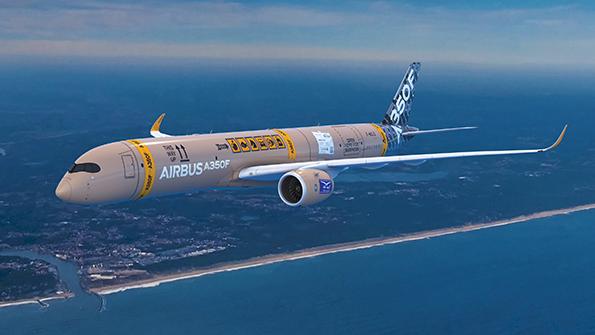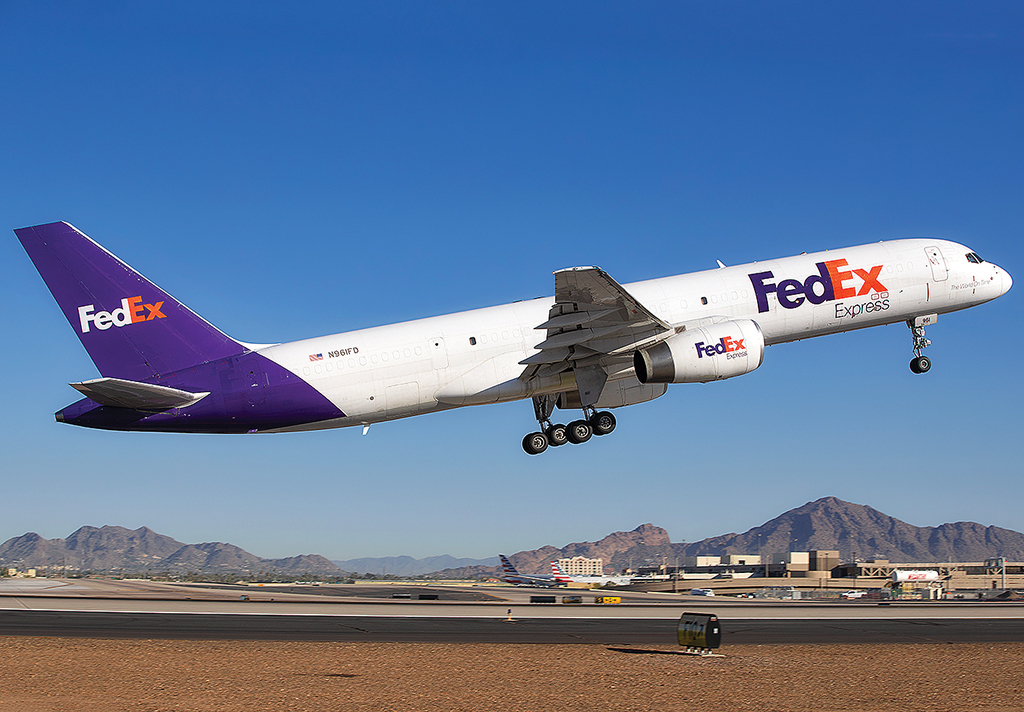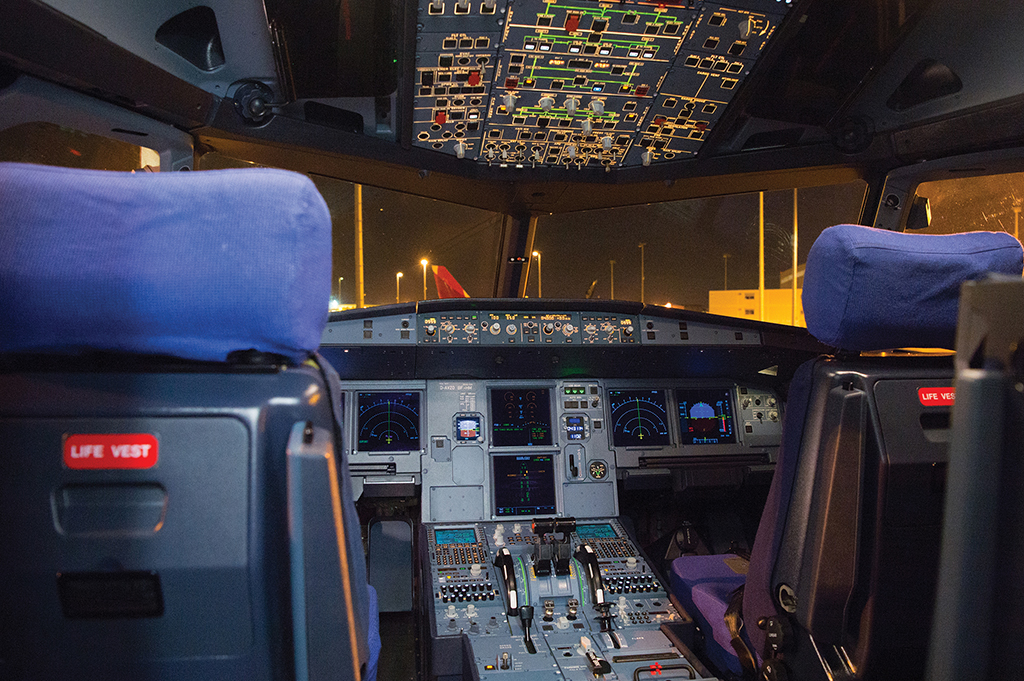Single-Pilot Operations Are Under Increased Scrutiny

The A350F could be an early platform to test reduced flight crew operations scenarios.
A push to develop procedures and new flight deck functionality that supplant a pilot even for short time periods is receiving increased attention from global labor groups that fear a direct path to aircraft designed for single-pilot operations.
The Air Line Pilots Association (ALPA), International Federation of Air Line Pilots’ Associations and European Cockpit Association launched a joint campaign against single-pilot operations (SPO) this year without flagging any specific projects. Soon, targets emerged: projects underway at Airbus and Dassault as well as a European Union Aviation Safety Agency (EASA) study on extended minimum crew operations (EMCO) and SPO (AW&ST June 13-26, 2022, p. 32). EASA now says nothing will change before 2027, and SPO for commercial airline operations—if they ever happen—are much further off.
- Airbus and FedEx discussed single-pilot A321 and A350 plans
- EASA is studying concepts but does not have a timetable
- Pilot groups are unified in opposition
While regulators will drive any reduced-crew operations (RCO) timelines, at least two large industry stakeholders have considered plans with far more ambitious timetables than EASA’s latest public statements.
Airbus has pitched two new freighters to FedEx that would leverage having fewer pilots on board, Aviation Week has learned.
The more radical proposal is an A321F that would be type-rated for two pilots at the outset but would attain single-pilot approval over time, documents seen by Aviation Week suggest. The second concept is an A350F approved for EMCO—essentially permitting one pilot on the flight deck during low-workload cruise portions of the flight, which could lead to needing fewer pilots on long-haul flights that require relief crews under current regulations.
The ideas, pitched in early 2022 and dubbed Project Morgan, are not moving forward at the pace Airbus envisioned due primarily to regulatory hurdles. But details in the documents lay out the manufacturer’s thinking on how SPO could evolve.
Under Project Morgan, Airbus would further develop concepts trialed under its Dragonfly program, such as automated emergency descents. These would converge with EASA’s EMCO work, which focuses on evaluating the risks and potential benefits of allowing a single pilot on the flight deck during low-workload periods (AW&ST Jan. 24-Feb. 6, 2022, p. 50).
The A350F plan proposed to FedEx envisioned a formal application in 2022 and entry into service—with at least some RCO approvals—in 2026. This would follow rulemaking and standards development by both EASA and the FAA.
When EASA unveiled its EMCO and SPO study last year, its timeline aligned with Airbus’ FedEx pitch. Its original target was industry consensus on EMCO and some approved operational applications such as single-pilot flight decks during long-range cruise by the middle of the decade. While the broad vision remains in place, both the regulator and the manufacturer have throttled back.
“We have been asked to look at single-pilot operations [for freighters] as industry has been approaching us to look at the viability of the case,” EASA Acting Executive Director Luc Tytgat tells Aviation Week. “We don’t have yet a pre-application, just . . . a partnership agreement with the industry actor. They want to question us [on] whether it is realistic or not. We are at step zero of the process.”
Regarding timing, he adds: “There is not so much activity. We don’t see [entry into service in 2025 or 2026]. Single-pilot operations is not something immediate.”

Airbus “is constantly looking for ways to improve and advance its range of products to deliver higher levels of safety, efficiency and performance,” the manufacturer tells Aviation Week. “We believe that pilots will remain at the heart of operations for the foreseeable future and that automation can play a crucial role by assisting them in the cockpit and reducing workload. . . . Our studies are based on a minimum of two operating crew per flight and do not involve flights with only one pilot on board. As we do so, we are in constant dialog with our customers and the authorities.”
Airbus is developing an A350F that is scheduled to enter service in 2026. It has not launched a new-build A321F.
“We have no further comment about the launch of an A321 freighter version,” the manufacturer says. “There are many studies, but not all of them see the light of day.”
Whether Airbus has shelved its A321F SPO plan or simply set it aside is unclear. But as recently as last year, it was crafting a sales strategy around the concept.
The A321F SPO plan included application to both EASA and FAA in 2023 and entry into service in 2027, according to the documents seen by Aviation Week. In parallel, Airbus would support development of what it dubs the “single pilot/second pilot-optional” certification project that would pave the way for full-mission SPO. FedEx would work with the FAA on operational details, including a pool of pilots trained to fly either alone or in traditional crew pairs. The ambitious project aimed for entry into service by 2030.
Several industry sources said the FAA’s list of near-term priorities does not include any substantial RCO work.
A FedEx pilot union source said Project Morgan has not been discussed with its ALPA-represented membership. FedEx did not respond to Aviation Week’s inquiries.
The increasing activity around RCO and pilot unions’ concerns stem from multiple concepts converging.
Automation’s evolution is bringing capabilities to the flight deck that supplant pilots. Airbus last year selected Thales’ PureFlyt as one flight management system (FMS) option for the A320, A330 and A350. Among the functionalities that Thales is building into the system is a “pilot assist” function, Yannick Assouad, executive vice president for avionics, revealed during this year’s Paris Air Show.
Designed to automate weather-related route changes and other unexpected flight plan diversions, PureFlyt will start as a function pilots must opt to use. Remove that critical step, however, and it becomes part of a truly automated FMS functionality.
“You can easily imagine a system that has [data from] millions of flights integrated—all the failure scenarios that you can imagine in the airplane and procedures to answer them are automatically loaded in that system,” Assouad said. “It can become a flight assistant with no pilot [activation]. It has the power to absolutely do that.”
While true SPO will require a step change in automation, aircraft designs also must evolve.
When industry shifted away from having a flight engineer as the third person on the flight deck, aircraft designs changed. Boeing Chief Pilot and Vice President for Flight Operations Craig Bomben suggests a similar shift would be needed to introduce single-pilot scenarios safely.

“As far as I know, there has not been a commercial airplane built yet that was designed for single-pilot operations,” Bomben said at a recent ALPA conference. “Because of that, there are certain things you cannot do from a single seat,” he added, using a jammed control as one example. “Solving that requires both pilots.”
As aircraft designs evolve, industry is exploring more reduced-crew scenarios on today’s aircraft. The concept dates back decades, starting with so-called controlled rest—or planned naps—in the cockpit.
EASA is among many regulators that, under very specific guidelines, allow one pilot to take a nap in their seat while the other stays at the controls. The European air transport industry took advantage of a 1989 NASA study published in the International Civil Aviation Organization’s journal the following year, flight safety consultant Bertrand de Courville explains.
“As a guiding principle, taking some rest in flight helps being in a good shape for critical flight phases, such as approach and landing,” says the French Air and Space Academy member and former Air France captain. “Electroencephalography shows sleep is a physiological need; it is no use trying to fight it. If you do not rest to recover vigilance, you will have a drop in alertness or fall asleep before you know it.”
The idea is to take a nap without settling into deep sleep. The total duration should be around 30 min., including a wake-up phase. Proponents say the practice helps prevent loss of vigilance but has limited impact on fatigue. Loss of vigilance and fatigue are different, even though building up fatigue paves the way for losing vigilance.
“Briefings are key,” de Courville says. Under the framework set by EASA for each operator to create its own procedures, briefings take place before and after the controlled rest period. Before, the crew discusses the situation, upcoming tasks and the possible need to wake up the sleeping pilot. After the rest period, the pilot who stayed awake briefs the other on the situation.
The FAA has studied it and even prepared a draft advisory circular (AC) in the early 1990s that would have allowed it. But opposition from pilot unions, notably ALPA and the American Airlines-affiliated Allied Pilots Association, kept the AC from being adopted, and subsequent guidance has codified the FAA’s position.
“The FAA authorizes inflight naps for flight crew if there is an augmented complement so that two pilots are on the flight deck while the augmented crewmembers are resting,” states a 2010 Basics of Aviation Fatigue AC. “Although a number of foreign air carriers authorized in-seat cockpit naps during flight, the FAA does not authorize such in-seat cockpit naps.”
ALPA President Jason Ambrosi says the union’s position has not changed. “Controlled rest is not a solution for fatigue,” he says. “That should not be a stopgap for proper rules. Our fatigue rules here in the U.S. allow for multiple pilots on long legs. There’s fatigue mitigation through actual rest, not controlled rest.”
ALPA sees controlled rest and EMCO’s allowance of one pilot on the flight deck while a second pilot naps as not just poor regulatory policy, but steps toward true SPO.
“There is no safety argument to be made” for having one pilot on duty at a time, Ambrosi says.
ALPA is backing its stance with contract language. Recently crafted pilot agreements at Delta Air Lines and United Airlines include provisions that require two pilots, for example. United’s contract updated the previous language that specified having two pilots on the aircraft. Now they must be on the flight deck.
Boeing’s Bomben acknowledges that the company’s automation-related research, which CEO David Calhoun has said will be a significant driver in its next clean-sheet airplane design (AW&ST June 19-July 2, p. 42), includes RCO concepts. “This has picked up a head of steam, and we could not ignore it,” Bomben said. “So we’re looking at it.”
Boeing’s approach is straightforward, Bomben said. It is looking at failure scenarios one by one and determining whether automated functionality might assist. It also is examining how the same scenarios would be affected by having one pilot at the controls, even for a short stretch.
So far, the results are sobering. One example is a notional EMCO scenario with one pilot on the flight deck while a second is napping in the crew rest area. The pilot flying has a seizure and inadvertently disconnects the autopilot. “Now you have an airplane that is not being flown,” Bomben said.
Malicious actor scenarios are another category that seems to conflict with permitting only one trained pilot on the flight deck, he added.
“There is a lot of technology being developed out there right now being touted as the technology required to go to reduced crew ops,” Bomben said. “Boeing is not going to support an effort that doesn’t meet an equal or greater level of safety.
“I’m not saying we’re not going to get there at some point,” he added. “But I’m telling you right now there are a lot of questions that need to be answered.”
—With Christine Boynton in Boston



Comments
Modern airliners, especially those which have full auto land capability, can safely be operated by a single rated pilot and a systems operator/radio operator (SO/RO). The USAF is already reviewing a similar system for KC-46.
The SO/RO would have an instrument rating and be trained to run checklists, talk on the radio, fly the aircraft using auto flight, and couple the auto landing system. The SO/RO would also be trained in the simulator to hand fly an ILS approach using the flight director and to manually land the the aircraft. For initial qualification the SO/RO could also make three actual landing in the aircraft.
In line operation the SO/RO could be allowed to fly the aircraft after takeoff above 1000 feet AGL and, on approach, to decision height. The SO/RO would also be required to make 3 coupled auto landing each half.
In the event of the incapacitation of the rated pilot, the SO/RO would be required to land the aircraft using auto land at the nearest suitable airport.
If society is going to allow quad copters using full autonomy to carry people, it makes little sense to prohibit a SPO in the airlines.
Bernard Guillaume